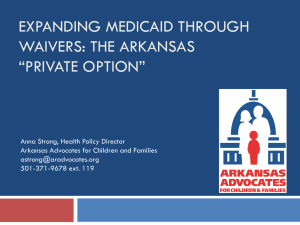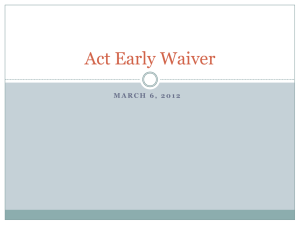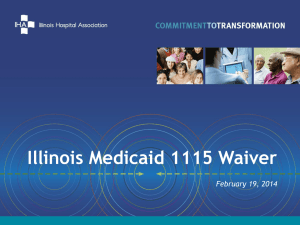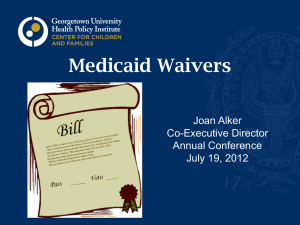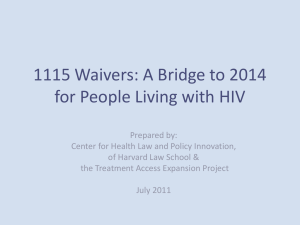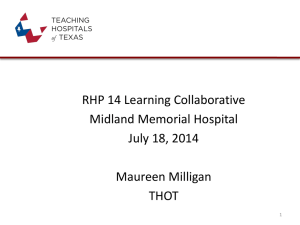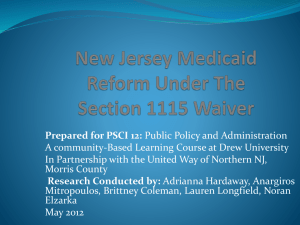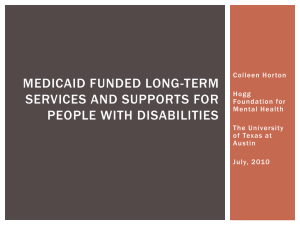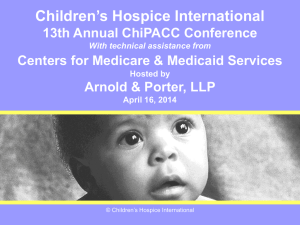Nevada DHCFP 1115 Waiver Concept
advertisement
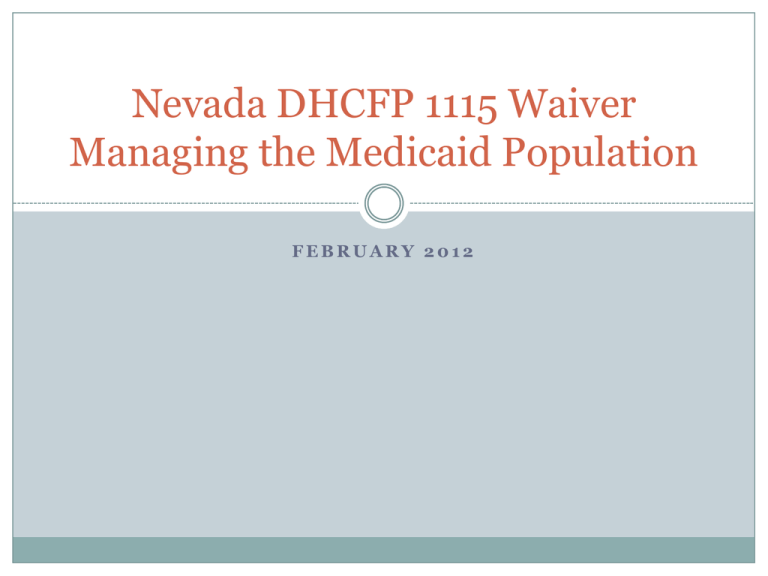
Nevada DHCFP 1115 Waiver Managing the Medicaid Population FEBRUARY 2012 Vision to Manage the Medicaid Population 2 Project based on DHCFP Legislatively Approved Budget Project initially will provide management for Nevada’s high need (chronic conditions or based on utilization patterns) fee for service (FFS) population (with some exclusions). This will be done through the use of: Care Management Organization (CMO) RFP was released on February 1st 2012 with planned program initiation in August 2012. Pilot Health Homes with planned RFP release in Spring of 2012 and implementation in Fall of 2012 If found favorable, the project will extend to manage all Medicaid recipients either through a managed care organization or a managed FFS program. Managed Fee for Service 3 The health home and the care management programs integrate the medical care, behavioral health and long term care needs of the patient into one coordinated plan of care through a medical team all focused on the needs of the patient. They monitor and manage provision of patient care through case management and health information technology. They utilize national benchmarks to track outcomes (hospital re-admit rates, ER use, well child visits) Payment may be: A per-member per-month dollar amount, Payment for improved outcomes (usually indicating savings), An increase in the regular service rate, Or a combination of these. Health Home Care Integration 4 Care integration includes: Obtaining a “health home” – a primary care provider responsible for overall coordination Medical disease management for persons with mental illness; mental health management for persons with chronic medical conditions Preventive healthcare screening and monitoring by mental health providers; mental health screening and monitoring by primary care providers Integrated and consolidated mental health and medical services Medication adherence both mental health (MH) and non MH medications Assisting in scheduling and keeping appointments Monitoring follow through, developing health and wellness services Verify healthcare services are occurring by utilizing data management Providing real time healthcare information to appropriate healthcare service providers Comprehensive Care Management Organization (CMO) 5 The CMO would: 1)Complete the integrated Care Management; and/or 2) Develop a cost-effective infrastructure (health care information exchange, data analysis and performance measurement, care coordination and patient outreach, patient education and wellness services) to help small medical practices meet the requirements of a health home, thereby promoting the expansion of health homes in Nevada. (Nevada currently only has a few medical practices that have the infrastructure to be a health home.) Issues that Developed 6 Per Discussion with CMS, it was determined Nevada would require a Section 1115 Wavier: The scope of desired health homes and care management programs were not an option under the Medicaid State Plan. The programs would require Medicaid to waive sections from 1902 of the Social Security Act through the use of a demonstration project waiver, a Social Security Section 1115 waiver . Nevada would not be able to fund health homes or a case management organization for patients receiving case management through existing programs (Targeted Case Management (TCM) and medical case management provided to community long term care clients (Home and Community Based Waiver clients)) as this would be a duplicative medical service. Current Plan 7 Develop Health Home and Care Management program that integrates the medical/behavioral health and long term care needs for persons not enrolled in Medicaid managed care plans and who have a chronic condition or a service utilization pattern that indicates they are at high risk. Initially exclude persons who are receiving TCM, longterm care waiver services or are in the state or county child welfare and juvenile justice systems as this would preclude the duplicate funding for the case management these services depend on. (Long term alternate planning needs to be completed to determine how and when this population would be able to be included in the health homes program.) An 1115 Waiver is Needed in Phase 1 to : 8 Use innovative care delivery models including per person per month type provider payments, shared savings options and pay for performance. Tailor some programs to specific populations or age groups (health home specific to children with cardiac conditions or adults with severe diabetes pre end stage renal disease). To limit some programs to Medicaid and not the dual Medicaid/Medicare population. To mandatorily enroll or exclude specific groups. To act expeditiously when opportunities present, having to go through the CMS amendment process. Overall Timeline and Waiver Needs of 1115 Waiver Phase 1 • PHASE 1 (listed times contingent on CMS approval time frame) JUL 2012 • Care Management Program Lock in. (Freedom of Choice, 1902(a)(23)) JUL 2012 • Implement Medical Home pilots for high need/chronic condition enrollees. (Comparability 1902(a)(10)(B); Payment Reforms 1902 (a)(13)&1902(a)(30)) AUG 2012 AUG 2012 SEP 2012 • Implement Care Management Organization (CMO) for high need enrollees where medical home not available or as alternative. (Comparability 1902(a)(10)(B)) • Expansion of Health Homes with CMO infrastructure Support. • Implementation of Comprehensive Health Homes (integration of medical, behavioral health and long term supports). 9 An 1115 Waiver is Needed in Phase 2 to : 10 Continue these Phase 1 needs: Use innovative care delivery models including capitation of service provider payments (shared savings options and pay for performance). Tailor some programs to specific populations or age groups (health home specific to children with cardiac conditions or adults with severe diabetes pre end stage renal disease). To mandatorily enroll or exclude specific groups. To act expeditiously when opportunities present, having to go through the CMS amendment process. To implement meaningful benefit design changes (capped benefit unless participate in care management). Overall Timeline and Waiver Needs of 1115 Waiver Phase 2 11 • PHASE 2 SEP 2013 SEP 2013 DEC 2013 • Implementation of Integrated Care for Dual Eligible's (coordinate with Medicare for shared savings). (possible integration on 1915(c) waivers into the 1115 waiver) • Expansion of Managed Care for exempt populations (SED, SMI, foster care). • If Data projects beneficial, Implementation of Managed Care for Other Populations not already included. Care Delivery System Changes 12 There will be three primary delivery systems under the section 1115 waiver, DHCFP currently has (1) for the TANF/CHAP/CHIP populations and would require CMS approval of the 1115 waiver to implement (2) and (3): (1) HMOs, Managed FFS (2) health homes, and (3) care management organization/administrative service organization. Potential Program Population based on SFY 2011 Claims data 13 Definition Caseload Dollars •Total Medicaid FFS (excluding those who have Medicare) population who have a diagnosis of Chronic Condition on a medical claim 66,379 $808,752,072 •Of those persons, the number of combined TCM, Child Welfare or Waiver patients 12,539 $253, 738,669 •The number of those with Chronic Conditions who are not in TCM, Child Welfare or the Waiver 53,840 $555,013,403 Other Waiver Authority Requests 14 These other waiver requests could be beneficial to the State through providing greater flexibility: Managed care rate setting rules that require the rate to be actuarially certified (actual service cost plus) versus best practice/trends (working with CMS to determine ability and regulation) Once a care management option is chosen, mandatory program lock in until yearly open enrollment (similar to private group insurance plans) (freedom of choice 1902(a)(23)) Elimination of prior quarter coverage for certain new Medicaid applicants (1902(a)(34)) (may not be possible under MOE rules)
